To honor Pep Guardiola’s Barcelona team and their unique possession game which dazzled their opponents, fans and pundits with its quick short passes, smart movements and positional interchange, I have recreated Pep Guardiola’s Barcelona Tiki-Taka Tactics in Football Manager 2024.
This extreme possession tactics created for Football Manager 2024 look to give you both a closer look at the main system of play used by Josep Guardiola under his managerial tenure at FC Barcelona, and how I have used his positional system as a framework to emulate Barcelona’s style of play under Barca’s Guardiola era.
Here I’ll be taking a closer look at the tactics used from the legendary 2008/09 season to the 2010-11 season which – a golden era for the Spanish side that resulted in two Champions League trophies, three consecutive La Liga Championships, one Copa del Rey trophy, as well as winning the FIFA Club World Cup in 2009 and 2011.
Let me present Passion4FM’s Football Manager 2024 Barcelona Tiki-Taka Tactics which emulates the principles of positional play to recreate Barcelona’s Tiki-Taka style and playing philosophy between 2008-2011.
Table of Contents
Creating the Ultimate Possession Tactic on Football Manager…

When I should recreate the Barcelona Tiki-Taka tactics in Football Manager, I felt it was necessary to give you an insight to what I emphasize the most when trying to emulate the Guardiola’s tactical system – actually giving you the foundation to recreate similar tactics founded upon the core principles of Pep Guardiola’s positional play in Football Manager. I felt I could not only publish such a possession tactic without trying to explain the playing style more in-depth by handing you a tactical analysis of the tiki-taka playing style.
There I showed you the main principles and characteristics of Pep Guardiola’s football philosophy and how he looked at possession or the positional play as the main tool to dominate any opposition – using overloads and compactness within a balanced system, movements and quick one-twos to destabilize the opponent’s defensive block by aiming to move the opposition team from side to side with intricate passing play to eventually create gaps to penetrate. All along with the objective to move the ball into weak areas of the opposing system whilst remaining fitter than them; both mentally and physically.
After reading my tactical analysis of Barcelona Tiki-Taka playing style you should have understood;
- the importance of the positional system in order to overload the opposition in all phases of play,
- creating numerical superiority, which makes you able to dominate and control the opposition style of play in a bid to make their play more predictable to counter,
- understand the importance of shapes to aid ball circulation and chance creation in additional to the benefits of a high-pressing game in order to limit the opposing players time on the ball to record extreme amount of possession which we aim for in order to control the match.
For now, I will leave the real-life analysis as a valuable appendix to create the base of the tactic, and focus more on how I have set up my Barcelona Tiki-Taka tactics and share with you what I emphasize the most when trying to emulate Josep Guardiola’s positional play.
By continue reading, you’ll learn more about the principles of Tiki-Taka and its key ingredients as well as getting access to the different tactical systems used by Pep Guardiola between 2008-2011 which you can download and import into Football Manager.
Download Pep Guardiola’s
Barcelona Tiki-Taka Tactics for FM24
Get Passion4FM’s Football Manager 2024 Barcelona Tiki-Taka tactics, that are founded upon Pep Guardiola’s positional play. Control and dominate matches with free-flowing passing football, beautiful movements and create more distinct goalscoring opportunities than the opposition.
Published: 24.01.2024
Version: 1.0
FM23 Tiki-Taka Tactics – Download
About the FM24 Barcelona Tiki-Taka Tactics; What Can You Expect From Downloading?
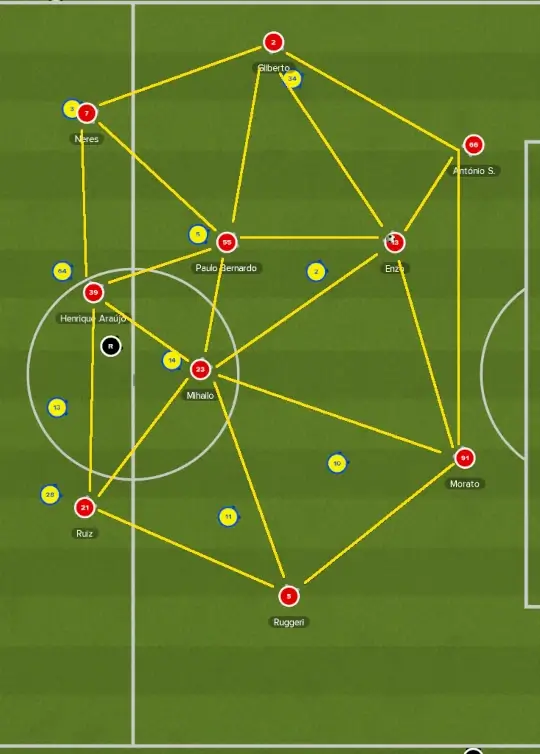
The Barcelona Tiki-Taka tactics is created for everyone who;
- … prefers extreme possession (above 60%) to control the match and thereby dominate any opposition. It’s not unordinary to experience +600 passes completed per match with over 15 key passes per game
- … feels more comfortable when the ball is in the opposite half rather than countering from deep.
- … sees pressing as a tool to control the opposition and hereby force mistakes.
- … sees the benefits of utilizing a balanced system that is as defensively solid as attacking fluid in order to concede fewer goals and create more distinct goalscoring opportunities
- … enjoys expansive football with lots of movements (overloads and underloads) that breaks down any opponents, interchange in passing, and quick one-two’s which results in beautiful goals leading from clever through balls.
The beauty of Passion4FM’s Barcelona Tiki-Taka tactics is that they give you total control – literally dominating any opposition*. You’ll experience a high amount of key passes that unlock ‘any’ tight defences, overloading key areas and giving the opposite team no rest with shots coming from in or around the penalty area and players utilizing pocket of spaces which outnumbers the opponent.
*Disclaimer! How much you dominate the match depends on how you analyze the next opposition, set up opposition instructions and finally pick team instructions both before and during the match to maintain control – either you look to retain possession or play more expansive football.
By downloading Passion4FM’s Football Manager 2024 Barcelona Tiki-Taka tactics you can expect to record lots of passes (hopefully twice as many as the opposing side) and a high number of key passes. By incorporating constant overloads and overlaps when in possession, especially when entering the final third, this FM24 Barcelona Tiki-Taka tactics looks to record a higher expected goals value per game than your opponents, as it looks to create more distinct goalscoring opportunities than the opposition with shots coming from in and around the 18-yard box after intelligent through balls, fluid movements in the attacking phase by constant overloads and overlaps that create the necessary space for each other to pick apart the opposition’s defensive organization.
It uses pressing as a tool to dominate the opposition and dominate the opposition in their own half resulting it to be a defensive solid system that hopefully sees you concede the least amount of goals within your league whilst scoring the most, something that will replicate the feats of Josep Guardiola and FC Barcelona’s goal scoring ratio.

I can’t promise you titles or high score lines, as this will depend on your team, the opponent and basically how you analyze the match tactically both before and within the match, or how you decide to conquer the opponent’s weaknesses. However, I can promise you the feel of playing as FC Barcelona from their incredible Guardiola era as I’ve tried to make it as close to reality as possible, within the frameworks (read limits) of Football Manager and its match engine.
For me, the objective is not to record match results where I win 8-0 and have 50 shots per game or something like that. Instead, the main objective is to implement the characteristics of the tiki-taka playing style with its movements and positional play as close to reality as possible.
I have tailored these tactics after Josep Guardiola’s philosophy at Barcelona and their players. For instance, the system used in the highly successful 2009-2010 season but also focused on the general characteristics of Pep Guardiola’s ideas. I’ve tried to make a summary of the key ingredients of Pep Guardiola’s Barcelona systems, which you can read more about below.
As the years have gone by I can’t hide the fact that I may have become influenced by how Barcelona played after 2010 as well and new concepts Guardiola has introduced after that, or the new players that have come to take the specific positions in FC Barcelona afterwards and made an impact and a personal impression on me. At the same time, I’m afraid certain tactical instructions have caught my attention to the level that it’s become how I see Barcelona played under Pep Guardiola. This will be evident in the selected player roles and duties in this Football Manager 2024 possession tactic that looks to summaries three seasons of magnificent football.
You must also take into consideration other minor modifications to the player roles and duties of Football Manager, or certain tendencies in the match engine, which might make it more difficult to replicate a certain tactical system 100%, herein its penetrating movements and passes.
In the end, these tactics are only my interpretations of Josep Guardiola’s tactical system at Barcelona and how I find it appropriate to replicate it in Football Manager as close to reality as possible, in regard to the research done and what’s capable within Football Manager.
What We Always Should Aim For:
Before giving you further insight into the Barcelona tactics, I think it’s necessary to elaborate about some of the aspects of it, which I strive for on a match per match basis. These objectives may force you to vary the formation and the setup of player role duties from match to match or make some necessary adjustments to the team instructions according to the opposition’.’s shape.
In order to utilize a tactic based on positional play it’s important to understand what I and everyone else who incorporates such a playing style should strive for in order to consider it successfully implemented;
- Create more obvious goal-scoring opportunities than the opposition
- It can be translated to how many situations a player would normally score 9 out of 10 times or when you expect him to score. In Football Manager the result of clear cut chances can be used to show how many obvious goal-scoring chances you got. An higher expected goals value will also paint the picture of how well the chances your team creates.
- Regain possession as quickly as possible and as close to the opponents goal as possible with a high pressing style
- Record numerical superiority in key situations like when building out from the back and outnumber the opposition either it’s in the attacking phase or the defensive phase
- Creating numerical superiority might demand subtle changes to the formation, player role duties or, in worst case scenario, player position and player roles, as there are major differences of playing against a 4-4-2, a 3-5-2 or a 4-2-3-1 formation. It may also be minor alterations of the setup of player roles and duties of the opponent which makes it difficult to create numerical superiority at the different phases of play making it harder to enter final third or play out from the back.
- Increase the amount of passing options for the player with the ball, either it’s done naturally by player positioning from the shape of the formation or by duties and movements
- One example is this screenshot of the ideal passing network.

- Make the opposition team predictable with the ball by limiting the amount of passing options to as few as possible – in best case scenario to only one!
- Here will the width of the formation, the level of opportunism and specific player instructions and opposition instructions be of help, in order to force the ball to specific locations of the pitch that’s most desirable in order to regain possession
- Dominate the match by playing at your strength and create spaces to penetrate and not become too predictable while searching for weaknesses by being patience. It’s necessary that the team is better with the ball than the opposition and excels in one on one situations – being qualitative superior and features the technical abilities to retain possession in the most congested situations.
- At last, the team should be as equally dangerous from both flanks, as well as the centre. The ideal screenshot of focus of attack should look something like this; *
This means that this playing style and the tactics available for download is NOT at all plug-and-play tactics, as it may be required to make slight adjustments according to how the opposition plays and how the match evolves. What you see as satisfactory may depend on the current abilities of the team and the state your team in, before heading into the match.
The current tactic made available can be considered as a framework. You might want to tick or untick specific team instructions when you hunt for a win in the last 20 minutes of the match or are leading by one in the final ten minutes of the match, or change a player role to ensure numerical superiority in specific areas of the pitch – e.g FB-S to IFB-D to better defend against 4-2-3-1 systems using IWB-S.
A Background
Since 2013, my ambitions have been to create the ultimate possession tactic in Football Manager using Pep Guardiola’s positional play as a canvas to dominate the opponent and recreate the feats of Pep Guardiola’s Barcelona masterpiece – the most successful club in the 21st century!
Within four seasons, Josep Guardiola, a former deep-lying playmaker, guided FC Barcelona to fourteen titles; hence six trophies within one calendar year and two Champions League trophies.
Featuring three of the best playmakers the world has ever seen in Lionel Messi, Xavi and Andres Iniesta, FC Barcelona dominated the opposition with their passing game and orchestrated attacking patterns.
At the end of Guardiola’s Barcelona era, a remarkable win percentage of 72,47% together with magnificent attacking football made pundits and fans praise the manager who revolutionized the Spanish way of keeping possession.
A playing style which would later be renown as Tiki-Taka.
The playing style of Barcelona’s Tiki-Taka is equally loved as it’s hated by football fans throughout the world. Some look at it with awe and admiration, while others mainly focus on the defensive part of the playing style – having made up their mind that it’s all about retaining possession for the sake of it without any major purpose.
What caught my attention and heart was the accuracy and intelligence in passing and movements, both with and without the ball which eventually overrun its opponents, no matter their playing style or formation. I simply loved how Spain and Barcelona passed the ball so quickly between each other that it wore out the opponents, which eventually made them do more mistakes and weakened their attacking system.
German Miroslav Klose spoke openly about the tiki-taka style of play and dominance when encountering Spain in the World Cup semi-final of 2010;
“When we eventually did get it, we were so exhausted from chasing that we couldn’t do anything with it.”
Miroslav Klose, World Cup 2010
The rise to fame of Barcelona’s Tiki-Taka Style
Tiki-Taka has its origin from the Total Football developed by Rinus Michel in the 1970s and is a refinement of the highly attacking fluid football which gave Ajax and the Dutch national team lots of fame. A football concept he brought with him to FC Barcelona in 1971 continuing the work of Vic Buckingham‘s short passing system (also a former Ajax manager in the early 60s).
One of the founding principles of Total Football was the focus on position switching within a group of players with an extremely high understanding of each other positional requirements and awareness of movements.
As the above article in Football Bible dictates, no player on the pitch had a specific position except the goalkeeper.
It benefited from creative and versatile players who had both the technical and mental attributes to take up the roles and position of each other. The unique positional interchange erupted to counter the specific man marking used at the time. For instance, within the Italian teams using the Catenaccio systems.
These players had played with each other for years and knew each other strengths and weaknesses and gelled perfectly. When attacking, everyone was part of it, even the fullbacks or the goalkeeper who was finally part of the passing play. Out of possession, aggression and lots of pressure were used to win back the ball as quickly as possible.
To summarize, it was universality and creative fluidity, aggression and pressuring, technical brilliance and higher physical conditions all wrapped up to become the art of football of that time.
The Tiki-Taka and Total Football have some similarities. While it in some ways was not as extreme in position switching and its level of fluidity it was definitely as tactical intelligent as Rinus Michels’ total voetball.
Both systems utilized a very high defensive line to regain possession as close to the opponent’s goal and limit the time and available space for the opposition to play their natural game.
“Estamos tocando tiki-taka tiki-taka”, was the phrase Andres Montes used in the World Cup 2006 to describe Spain’s way of keeping possession. The commentator used the term ‘tiki-taka’ to describe how the Spanish national team utilized the possession game to their benefit by passing the ball between the lines and into various channels – both moving and resting with the ball.
As the ball was swiftly moved from player to player without a stop, fans and pundits were in awe of the beautiful high-tempo passing- game that humiliated the opposing defenders.
By using quick one-twos, intricate passing patterns and movements between the lines and into space, FC Barcelona’s Tiki-Taka playing style became the superior system that brought Barca success.
The style of play took advantage of the players technical abilities, extreme levels of anticipation and vision which can be summed up as being able to read the game better than the opposing players, both in the defensive and attacking phase by better positional awareness.
In a historical concept, the tiki-taka was founded at a time where physical football – each players strength, the ability to man-mark their opponent and abilities to run and dribble with the ball was favoured. The game as we all love was on route to be a game for only tall physical players who were far more individualistic than the tiki-taka aims to be.
With tiki-taka, smaller players were finally seen as prosperous. These players have always needed to be far quicker with the reading of the game and a lot smarter with the ball and their positioning in order to compete against players who have far better physical strength.
A change to the offside law in 2005, magnified the importance of technically brilliant players – reducing the factor on size and strength even further, paving the way for Barcelona’s Tiki-Taka system.


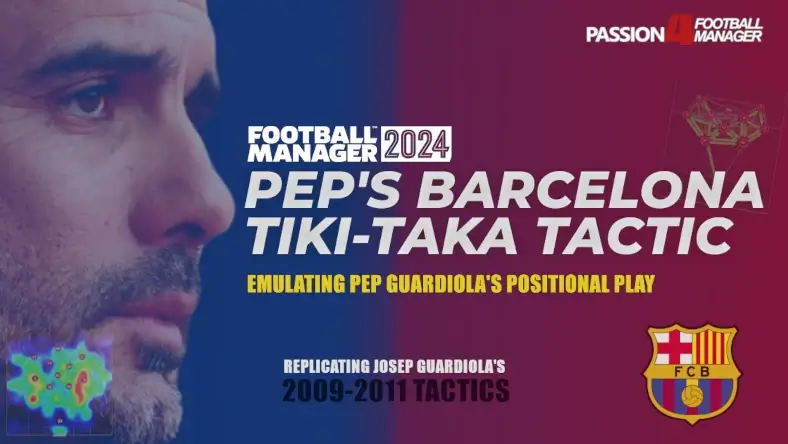
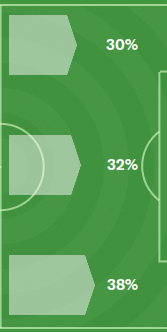


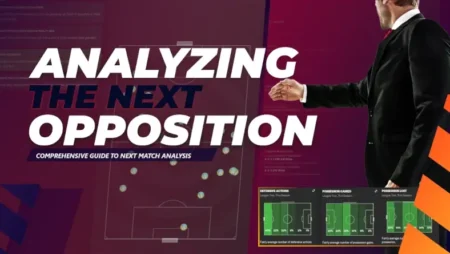
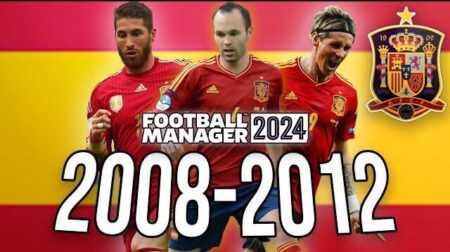
19 Comments
On Fm24 compared to last yr the Left IF-A effectiveness has dropped a lot compared to the right is there a reason why?
Good afternoon, I have a question, what can I do to keep the ball longer without moving it too much, just dribble less, or also put the be more expressive button on so as not to affect creativity?
Firstly, I would reduce the passing tempo if you feel it's too much direct. Dribble Less will also reduce the directness and players will instead retain possession more than before. Click be more expressive will increase creativity.
as I play with your tactic, and in the old opus you put dribbling less I had this question. but advise you to let dribble less untick at the beginning, and see during the match?
Sorry for all the doubts, but here in the tactic by default I have the underlaps selected but in the image here in the tactic they are not selected. 'it's normal?
Ciao! La tattica funziona veramente bene, Hai per caso un programma di allenamento aggiornato per Fm24?
Grazie e complimenti!!
I'm currently working on a training schedule megapack… testing and testing to see if I can get great development… Hope to release it this week if everything goes okey.
Ok grazie, ho letto anche che nella sezione che riguarda la tattica del 2008-09 del barça, c è scritto prossimamente, rilascerai a breve questa nuova tattica? Anche perché, L immagine che è sotto la descrizione non combacia con le tattiche trovate nel pacchetto che ho scaricato
Ancora una volta Grazie per il lavoro e per la pazienza che hai nel rispondere!
The 2008-09 tactic is in the package. I haven't taken the time to update that section or make a section for each tactic as I feel I need to focus on new content. That's the problem of maintaining the website alone.. I haven't time to update everything as well as publishing weekly, bi-daily content.
Sometimes, especially after new database releases I spend more time updating content than creating new stuff… Same goes for tactics and other testing once new ME version is out..So I can only apologize for not updating everything by point
What are the best teams to play tiki taka other than Barcelona?
Good morning,
When can we have the new schedules for fm24?
Trying my best to release them this week but I spent the last week testing them only to discover that I had made an error in the testing and the output was FAR better than the result as I had a mathimatical error in the Excel sheet. That resulted in trying to improve some schedules that actually worked very well and making them worse… Had to go back to try to find the good ones. But when every test I did went worse and worse, I got very frustrated. Hopefully able to release them within 1-3 days.
Hi Espen!! Looove your work!! Are you thinking about doing a recreation of Pep's Barca this year for FM 24 with the new roles that you can try to emulate movement of players such as Abidal and others? I would love to see your view on how to do it on this years edition of FM!
Great thread, I noticed the download pack doesnt have all the tactics noted/the tactics appear to be different than the ones explained, any advice?
Just a bit of laziness of me to update Everything for the latest version. It's easy to change the player roles and duty to what I show in the screenshots.
hi, congratulations for the great job!
I wanted to know when the tactical update will come out as I have encountered some problems after updating the game. Also I saw that there are new training plans, how can I use them better?
Thanks for the attention!
What tactic should to set for u-18 u-19
You would like to play with the 2-3-2-3 tactic. That's the one I have tested with the most. Depending on the type of striker you got, you can change to DLF if Treq doesn't suit you…but if you got an AF he will perform rather decent as Treq… I have managed Double with both Barcelona and Benfica – CL win with Barca and Lewandowski scored almost 0.9 goals per game
pic of opposition instructions missing